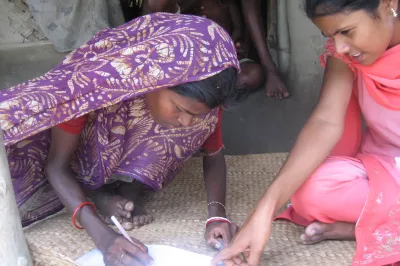Savings: Global Learning For Local Application
What can a study about 1,118 Nepalese women living in slums tell us about rural community savings programs in Colombia? Can we really compare such vastly different cultures, countries and contexts? And yet, there may be some core behaviors that are relatively consistent across geographies. Indeed, cross-border learning has been a key feature of the rapid innovation in financial inclusion products for low income and poor people.
 A woman crouches to collect shallow baskets of dried tea
A woman crouches to collect shallow baskets of dried tea
Photo Credit: Daniel Zoltani
Impact evaluations on access to finance, especially those of high quality, are few and far between and so it’s critical to learn from studies all over the globe. In fact, when the Multilateral Investment Fund (MIF) recently undertook a literature review of impact evaluations on microfinance conducted in Latin America and the Caribbean (Gutierrez and Soares, What is the Evidence of Microfinance Impact? 2011), they found that there was just one study conducted on savings in the region.
During a panel on “Access to Savings Services” at the recently held Asian Development Bank/IPA conference on Impact and Policy in the areas of Governance, Financial Inclusion and Entrepreneurship, Silvia Prina of Case Western Reserve University discussed her experiment on whether informal savers would move to formal savings accounts.
Her study randomly offered 1,118 women access to a fully liquid bank account. Results were dramatic, with 84% of households opening accounts and making deposits frequently. Monetary assets grew by 50% and total assets grew by 16%, indicating a real growth in assets and not merely a shift from illiquid to liquid. But, beyond this, the study also showed that households with accounts invested more in health and education, and that these investments resulted from small changes in behavior, such as spending less money on alcohol and cigarettes.
This, and other saving- related experimental studies, are driving important policy decisions at organizations like mine, showing how research on improving access to savings for the poor can be translated into useful insights to inform development programs.
First, they serve to clarify or challenge the “theory of change” that is behind particular development projects or programs - for example, the impact of a savings account on reduced “temptation goods” like alcohol and cigarette purchases is an unexpected finding.
Second, they conclusively demonstrate the impact of certain characteristics or features of products that make a difference. For example, Prina’s study used a no-fee savings account which may have been the reason for the high take-up rate. While this may be unsustainable for the private sector, an awareness of the strong impact of fees on clients is an important consideration for financial institutions trying to get into poorer market segments.
Third, they provide evidence that can help make a case for smart subsidies for private-sector led financial access projects, and can help development agencies allocate resources optimally.
So, clearly having robust research findings is very useful. And making the findings accessible and easy to understand so that the main messages are clearly delivered about what works and what doesn’t is crucial.
Within the context of the ProSavings program (www.pro-savings.org), in collaboration with the IDRC, Citi Foundation, AusAID, and CAF, MIF is funding innovations that seek to link beneficiaries of government cash transfer programs with formal savings products.
In addition to funding projects, we plan on investing significant resources on impact evaluations of these programs. Combining the learning from experiments like Prina’s with on-the-ground private-sector led programs designed to be sustainable will gradually build rich evidence on what products are viable for poor clients, how they save, why they save and how their savings affect households’ well-being over the long-term.
----- Sandra Darville is Chief of the Development Effectiveness Unit of the Multilateral Investment Fund at the Inter-American Development Bank Group (IADB).



Comments
Nice post Sandra. Your three
Nice post Sandra. Your three justifications for rigorous research are all spot on. I also like the point you make that the best research can generage global lessons even if the studies are local. Part of why we put money into rigorous studies carried out by top notch reseachers like Silvia is that a more rigorous and thoughtful approach is more likely to find the general lessons (disclaimer, the Gates Foundation funded this study through its MPII facility at Yale/IPA.)
Again, great post.
Thank you Jake and thanks for
Thank you Jake and thanks for funding this research. As someone working entirely in the LAC region, it is really important to be able to learn from other parts of the world, and I appreciate the transparency of the approach.
Add new comment